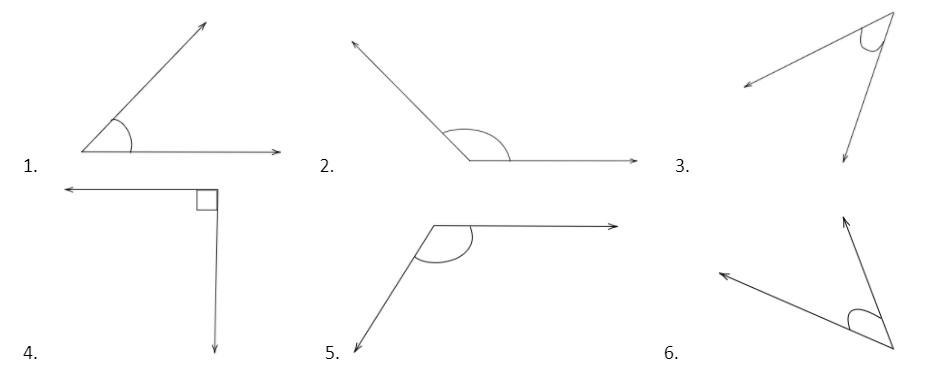Answer
399.3k+ views
Hint:The basic definitions of acute angle, right angle and obtuse angle area based on the comparison with the right angles. The notations used to show the angles at the vertex are also trivial; observe the notations shown in each figure carefully. Note that we can’t measure the angle by just looking at it.
Complete step-by-step answer:
First observe each figure correctly. The right-angle measures ${90^ \circ }$ and it is shown by a square drawn at the vertex.
The angle which measures less than ${90^ \circ }$ is known as acute angle and it is shown by a smaller angle than the right angle at the vertex.
The angle which measures greater than ${90^ \circ }$ is known as the obtuse angle and it is shown by a greater angle than the right angle at the vertex.
We will start from figure 1. The first angle is less than the ${90^ \circ }$ therefore, we can safely say that it is an acute angle.
Now observe the figure 2. The second figure is greater than ${90^ \circ }$ therefore, we can say that it is an obtuse angle.
Similarly, the figure 3. The figure follows the line of figure 1 and it is an angle less than ${90^ \circ }$ therefore, figure 3 is an acute angle.
The fourth figure is clearly a right angle as it has a square drawn to its vertex.
The figure number 5 follows the path of the second figure and it has an angle greater than ${90^ \circ }$ therefore, it is an obtuse angle.
The last figure is the same as the third figure but in the different direction. Thus, it is also an angle less than ${90^ \circ }$ implies that the angle in the 6th figure is an acute angle.
Thus, in the given figures, figure 1, 3, 6 are acute angles, figures 2 and 5 are obtuse angles while the 4th figure is a right angle.
Note:Observation should be very keen in this case. There are different angles with different directions so don’t confuse yourself with the directions of the angle. Compare every angle with the right angle so that it will be easier to differentiate each angle with the right angle.
Complete step-by-step answer:
First observe each figure correctly. The right-angle measures ${90^ \circ }$ and it is shown by a square drawn at the vertex.
The angle which measures less than ${90^ \circ }$ is known as acute angle and it is shown by a smaller angle than the right angle at the vertex.
The angle which measures greater than ${90^ \circ }$ is known as the obtuse angle and it is shown by a greater angle than the right angle at the vertex.
We will start from figure 1. The first angle is less than the ${90^ \circ }$ therefore, we can safely say that it is an acute angle.
Now observe the figure 2. The second figure is greater than ${90^ \circ }$ therefore, we can say that it is an obtuse angle.
Similarly, the figure 3. The figure follows the line of figure 1 and it is an angle less than ${90^ \circ }$ therefore, figure 3 is an acute angle.
The fourth figure is clearly a right angle as it has a square drawn to its vertex.
The figure number 5 follows the path of the second figure and it has an angle greater than ${90^ \circ }$ therefore, it is an obtuse angle.
The last figure is the same as the third figure but in the different direction. Thus, it is also an angle less than ${90^ \circ }$ implies that the angle in the 6th figure is an acute angle.
Thus, in the given figures, figure 1, 3, 6 are acute angles, figures 2 and 5 are obtuse angles while the 4th figure is a right angle.
Note:Observation should be very keen in this case. There are different angles with different directions so don’t confuse yourself with the directions of the angle. Compare every angle with the right angle so that it will be easier to differentiate each angle with the right angle.
Recently Updated Pages
The branch of science which deals with nature and natural class 10 physics CBSE

The Equation xxx + 2 is Satisfied when x is Equal to Class 10 Maths

Define absolute refractive index of a medium

Find out what do the algal bloom and redtides sign class 10 biology CBSE

Prove that the function fleft x right xn is continuous class 12 maths CBSE

Find the values of other five trigonometric functions class 10 maths CBSE

Trending doubts
Difference Between Plant Cell and Animal Cell

Difference between Prokaryotic cell and Eukaryotic class 11 biology CBSE

Fill the blanks with the suitable prepositions 1 The class 9 english CBSE

Change the following sentences into negative and interrogative class 10 english CBSE

Give 10 examples for herbs , shrubs , climbers , creepers

Fill the blanks with proper collective nouns 1 A of class 10 english CBSE

Select the word that is correctly spelled a Twelveth class 10 english CBSE

How fast is 60 miles per hour in kilometres per ho class 10 maths CBSE

What organs are located on the left side of your body class 11 biology CBSE




